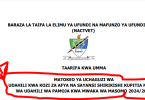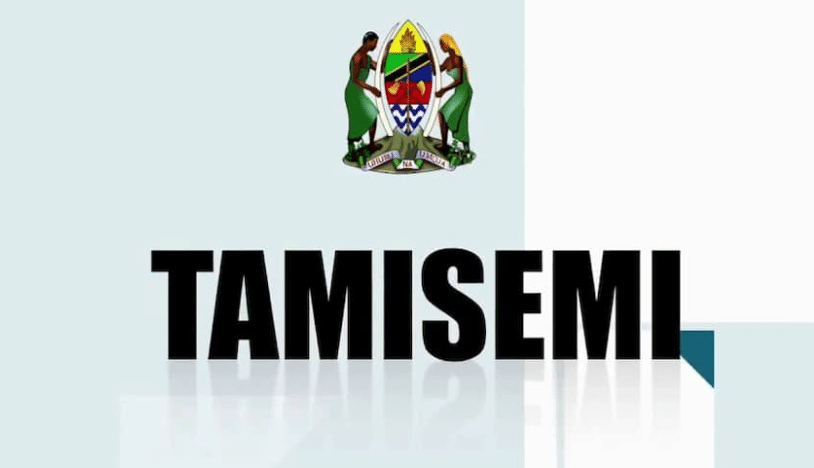Sifa za kujiunga na VETA (VETA entry Requirements and Qualifications)ntry Requirements and Qualifications) Here sifa za kujiunga na chuo cha veta, Vigezo vya Kusoma/kujiunga VETA, sifa za kujiunga na chuo cha ufundi, fomu za kujiunga na veta 2024, ada za veta, sifa za kujiunga na veta kipawa, waliochaguliwa kujiunga na chuo cha veta 2021, maombi ya kujiunga na veta.
Sifa za kujiunga na VETA (VETA entry Requirements and Qualifications)
2.0 Technician Certificate in Technical and Vocational Teacher Education (NTA Level 5) Entry Requirements
The minimum entry requirement for Technician Certificate in Technical and Vocational Teacher Education programme is possession of the National Technical Award (NTA) Level 6 in any technical or vocational profession or its eqivalent from a recognised technical institution.
Duration
The duration of this programme will be one year (12 months) if attended full time at Morogoro main campus or twenty-four months (two years) through a blended open and distance learning mode of delivery. This is a progressional level of study to NTA level 6 (Ordinary Diploma) for those who wish not to exit voluntarily at this stage.
3.0 Ordinary Diploma in Technical and Vocational Teacher Education (NTA Level 6) Entry Requirements
The entry requirements for the Ordinary Diploma in Technical and Vocational Teacher Education programme requires an entrant to have at least a National Technical Award (NTA) Level 5 in technical or vocational teacher education or its equivalent from a recognized institution.
Duration
This is a two-year (24 months) programme if attended full time at Morogoro main campus or three years (36 months) through a blended mode with open and distance learning delivery. The ordinary diploma in technical and vocational teacher education is a compulsory exit level of study.
4.0 Fees Ada Za Veta
More information on fee structure is available at http www.veta.go.tz
The Vocational Training System
The Vocational Education and Training Authority (VETA) is an autonomous Government Agency established through the Act of Parliament No. 1 of 1994 Chapter 82 [Revised in 2006]. The overall objective of the establishment of VETA is to oversee the Vocational Education and Training (VET) system in Tanzania. It is charged with the responsibilities of promoting, coordinating, providing, regulating and financing VET in the Country.
Vision
The vision of VETA is, “Tanzania with sufficient and competent artisans.”
Mission
The mission of VETA is, “To ensure quality vocational skills by providing, regulating, coordinating, promoting, and financing vocational education and training for national socio-economic development.”
Core Values
i. Demand-driven services;
ii. Service Excellence;
iii. Transparency; and
iv. Teamwork.
Roles Of VETA
i. Providing vocational education and training;
VETA provides training through 33 vocational training centres and institutes that it owns. Also, it provides training to vocational teachers through its Vocational teacher’s Training College in Morogoro.
ii. Coordinating vocational education and training;
VETA coordinates more than 700 VET institutions owned by other VET providers in the country, providing training in form of long courses, short courses and tailor-made courses. Also, VETA conducts Labour Market Surveys to determine skills demanded by the labour market.
As well, the Authority establishes and maintains close linkage and partnership with other training providers at national and zonal levels.
iii. Regulating vocational education and training;
VETA regulates provision of vocational education and training in the Country through Registration of VET Institutions; Accreditation; Setting Standards; Curriculum Development; Auditing for Compliance; Assessment; and Certification.
iv. Financing and managing VET fund;
VETA finances and manages VET Fund for Vocational Education and Training. The main source of VET Fund is employers contribution of Skills Development Levy (SDL). Employers with four and above employees contribute 6% of their employee’s salaries as SDL.
Some other sources of VET funds are Government development projects; development partners contributions; funds from internal sources like income-generating activities and training fees.
v. Promoting Vocational Educational and Training
VETA is charged with the role of promoting vocational education and training in the Country. VETA believes that the public can support VET if it is provided with adequate information about VET goals and activities. Promotion is carried by communicating VET to different stakeholders including the Government, parents, employers, employees, and donors. Other targets include current and prospective trainees, instructors; VET graduates legislators, trade unions, NGOs and the media.
VETA uses different media in communicating VET to stakeholders: through advertisement, VET week activities, public presentations, trade fairs and exhibitions and publicity. Others include newsletters, annual reports, brochures, VET catalogues, websites and other promotional materials.
Also Read;
- Fomu Ya Maombi Ya Kujiunga Na Mafunzo Ya Ufundi Stadi VETA
- Nafasi Za Mafunzo Ya Ufundi Stadi Vyuo Vya VETA Tanzania
- Vyuo vya Ufundi Tanzania | Vocational Colleges in Tanzania {VETA}
- (Ushonaji Na Udereva Veta) Kozi zinazotolewa veta Tanzanaia | Veta courses
- Kozi za VETA veta courses Tanzania
- VETA Application Form Free Download PDF
- Majina Waliochaguliwa kujiunga VETA
- Matokeo ya VETA VETA Examination Result
- Nafasi za kujiunga na VETA | Opportunities to join VETA (Ufundi Stadi VETA)





[…] Also, Read More About Sifa Za Kujiunga Na VETA (VETA Entry Requirements […]
[…] Also, You May Read Sifa za kujiunga na VETA (VETA entry Requirements and Qualifications) […]